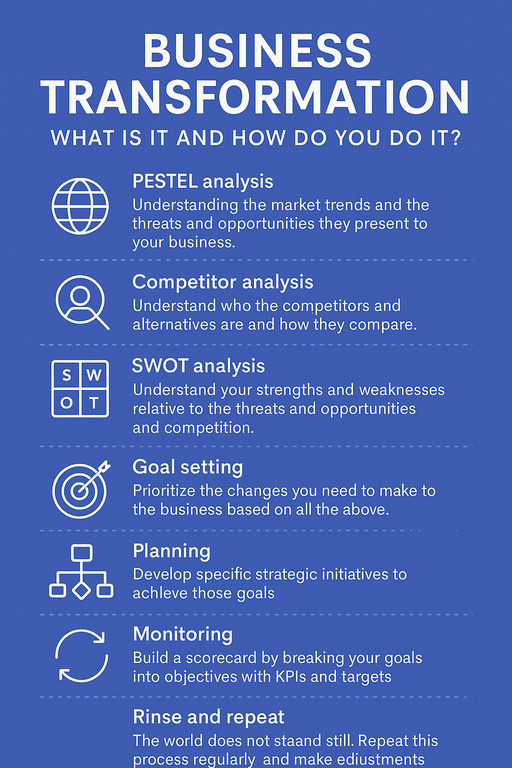 Everywhere you turn, someone is talking about transformation. Business transformation. Digital transformation. Increasingly, AI transformation. It’s become a buzzword—one that consultants, analysts, and tech providers use endlessly. But what does transformation really mean?
Everywhere you turn, someone is talking about transformation. Business transformation. Digital transformation. Increasingly, AI transformation. It’s become a buzzword—one that consultants, analysts, and tech providers use endlessly. But what does transformation really mean?
At its core, transformation is not about chasing the latest fad. It’s about preparing your organisation for the future. And because the future is always changing, transformation is never a one-off project. It’s an ongoing process.
The two fundamental questions of transformation
When you strip away the jargon, transformation comes down to two simple but powerful questions:
-
How are your customers’ needs evolving?
-
How can you position your business to meet those needs more effectively than your competitors—or any other alternatives your customers might choose?
Answering these questions is not easy, especially when both customer expectations and competitor landscapes are constantly shifting. But it doesn’t have to be as complicated as many billion-dollar consultancies make it seem.
A practical approach to transformation
Here’s a straightforward process you can use to make transformation tangible:
1. PESTEL analysis
Understand the political, economic, social, technological, environmental, and legal trends shaping your industry. These external forces create both opportunities and threats you must navigate. (Learn more: How to do PESTEL Analysis (with examples, template and AI)
2. Competitor analysis
Look beyond traditional competitors to the wider range of alternatives your customers might consider. How do you stack up against them? What differentiates you—and where are you falling short? (Learn more: A Comprehensive Guide to Effective Competitor Analysis)
3. SWOT analysis
Bring it all together. Map your strengths and weaknesses against the opportunities and threats. This reveals where you can win—and where you are most vulnerable. (Learn more: How to do a SWOT Analysis: with Examples, a Template and AI)
4. Goal setting
Prioritise. You can’t change everything at once. Which shifts will have the biggest impact in helping you stay relevant and competitive? (Learn more: Setting Strategic Goals)
5. Planning
Turn those priorities into concrete strategic initiatives. Allocate resources—budget, people, and time. Set milestones and make sure responsibilities are clear. (Learn more: Turning your strategy into action)
6. Monitoring
Develop a scorecard that breaks goals into measurable objectives with KPIs and targets. Track actual performance against plan, and ensure accountability. (Learn more: Creating a Strategy Scorecard on StratNav)
7. Rinse and repeat
The world doesn’t stand still—and neither can you. Review regularly (quarterly is a good rhythm). Stay flexible, adapt, and adjust rather than locking yourself into a rigid plan.
Transformation never stops
Transformation isn’t a programme with an end date—it’s a way of operating. The organisations that thrive are those that continuously anticipate change, respond to it, and reposition themselves faster and more effectively than the competition.
How StratNav can help
StratNav was designed to make this process practical, collaborative, and repeatable. From PESTEL and SWOT analysis to strategic planning, scorecards, and monitoring, StratNav gives you the structure and tools to drive real transformation—not just buzzwords.
➡️ Try it yourself for free today: www.stratnavapp.com
➡️ Schedule a demo to see how it works in action: Book a demo
➡️ Or, if you’d like to talk through your specific needs, book a free consultation.
